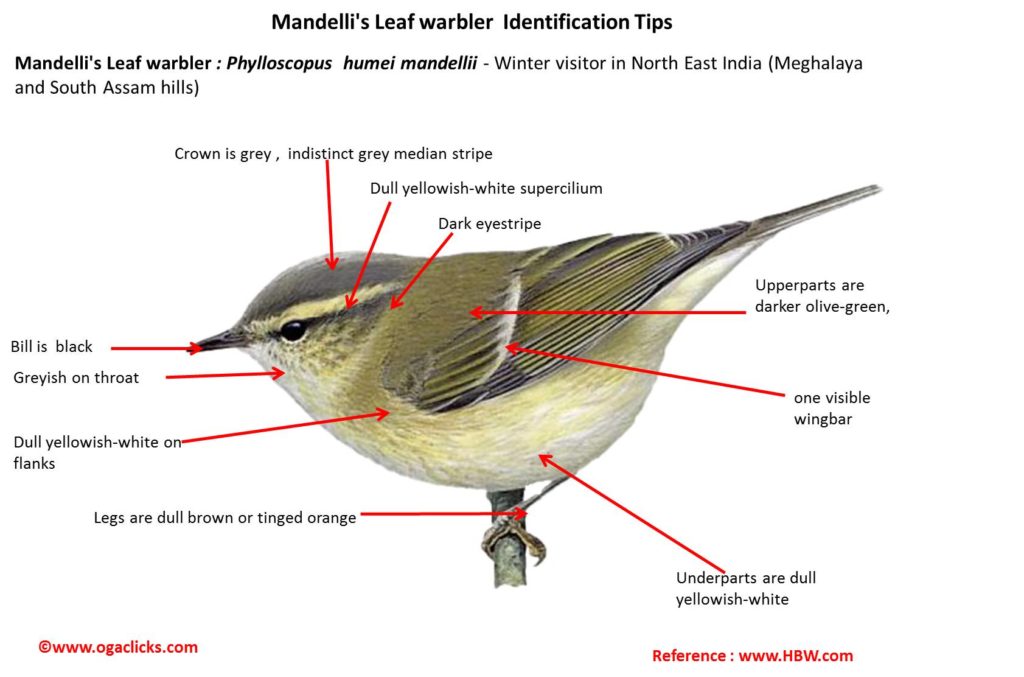Mandelli’s Leaf Warbler

Mandelli’s Leafwarbler Phylloscopus humei mandellii
Etymology:
- Phylloscopus : Greek word phullon – leaf; skopos–seeker
- Humei : Named after British ornithologist Allan Octavian Hume (1829–1912)
- Mandellii : Named after ornithologist Louis H. Mandelli (1833–1881)
Distribution in India: Passage migrant to Eastern Himalayas and winter visitor in North East India.
Description: Size of 10–11 cm; wt. of 5–8·8 g. It is a medium-sized, slim and active leaf-warbler with thin bill, prominent supercilium and wingbars. The nominate race has pale or dull buffish supercilium, long dark eyestripe; crown and upperparts are mostly olive-green, tinged with grey on crown and mantle, crown is broad and has a indistinct grey median stripe. The tips of median and greater upperwing-coverts are whitish-buff ; flight-feathers are dull brown with pale yellowish edges, whitish edges of tertials; whitish below, greyish on throat and breast; iris is dark brown; bill is mostly black, base of lower mandible sometimes with small area of pale or dull orange; legs are dull brown or tinged orange. It differs from all other leaf-warblers with small size wingbars, lack of yellow on rump and of white in tail, colour of wingbar on greater coverts, relatively narrow eyestripe, and all-dark .Both the sexes are alike. The juvenile has upperparts browner, wingbars are tinged buffish,supercilium and underparts are usually dingy white, and flanks are tinged buffish. Race mandellii has greyer crown and upperparts are duller and browner than nominate, upper wingbar rarely distinct, edges of tertials and tips of flight-feathers are greenish-grey, supercilium and underparts are dull yellowish-white.
Habitat: It breeds in larch and pine forests, also subalpine shrubs and rhododendron thickets.In breeding it is found from 2500–3980m. On passage and in winter it is found at lower levels below 2135 m in riverine woods and forest, open dry deciduous forest, woodland, orchards, plantations, gardens and roadside verges.
Food habits: It eats mostly insects, and their eggs and larvae; likebeetles, wasps, sawflies, ants,moths, dragonflies,flies, bugs, aphids , small cockroaches , Spiders and molluscs. It is usually alone or in pairs, but in non-breeding season frequently in mixed-species flocks. It forages at all levels, and both inside canopy and outside it, taking insects mostly from foliage; frequently hovers to examine outermost foliage; also pursues insects in agile, dashing and twisting flight. It may occasionally feed on the ground.
Breeding habits: They breed in May to Aug. They are monogamous; pair-bond known to last for several successive years. They are territorial. The pair formation takes place when female enters male’s song territory, both land on same branch and hop towards each other, with shivering wings half-spread and tail fanned and may raise tail above level of back, male then pursues female in flight. The nest is a ball of plant fibres, moss, grass and animal hair, placed on ground or bank among moss-covered roots or stones or concealed in grassy tussock, usually beneath bush, small tree or low-spreading rhododendron, sometimes in hollow in tree. They lay a clutch of 4–5 eggs. The incubation is done by female alone. The incubation period is 11–14 days. The nestlings are fed and cared for by both parents. The fledging period is 11–15 days. The young are independent at 21 days. The nests are parasitized by Lesser Cuckoo.